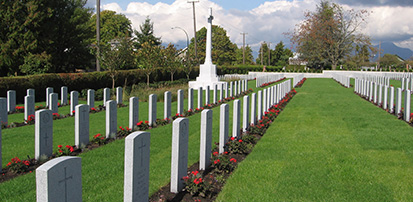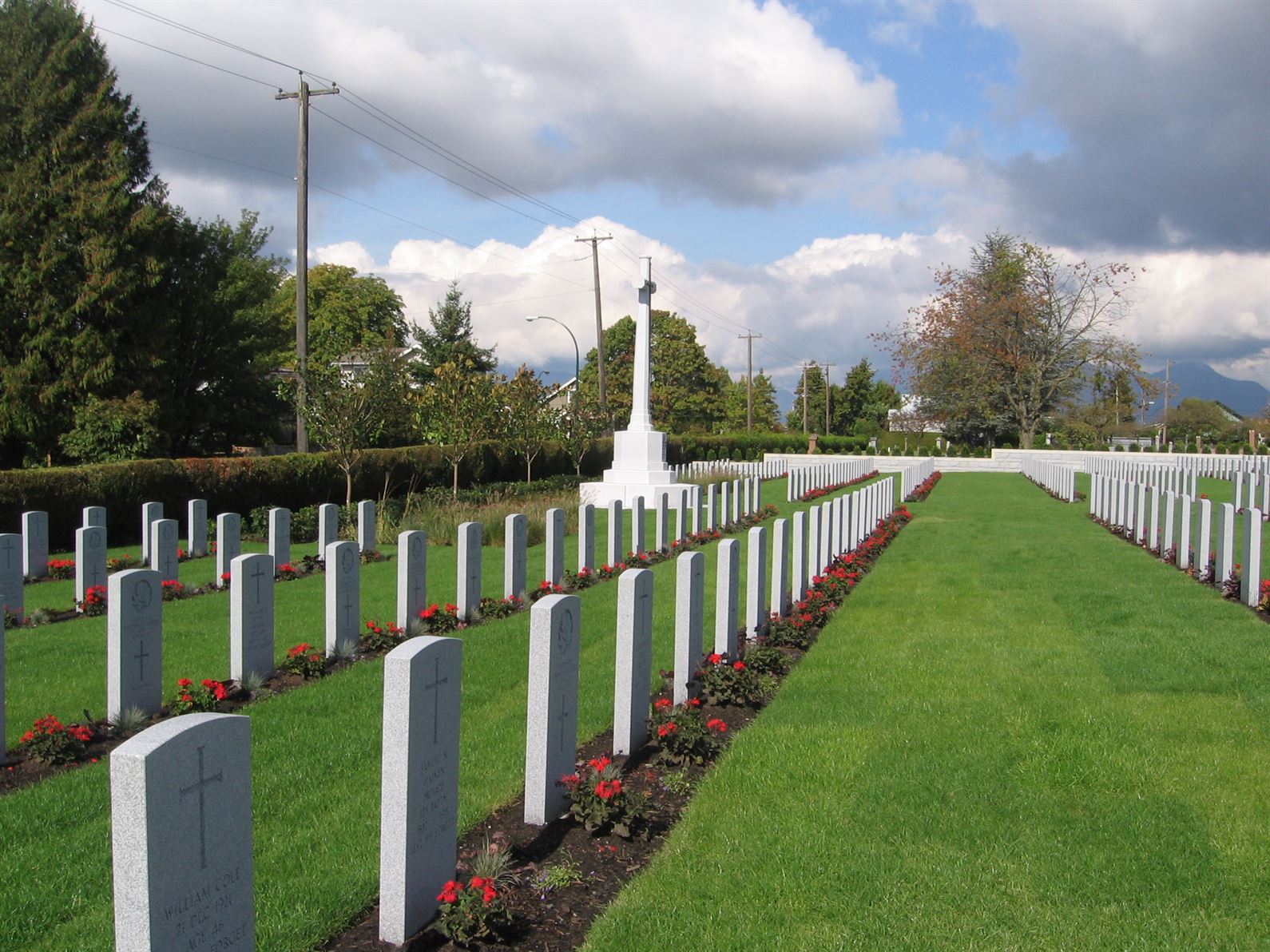Mountain View Cemetery
Mountain View Cemetery is the oldest cemetery in the Vancouver Metropolitan area. It began operation in 1887, with the acquisition of a parcel of land now known as the "Old Cemetery". It is bounded on the east by Fraser Street, on the south by 37th Avenue, on the north by 33rd Avenue, and on the west by a row of tall trees which today stand well within the present boundaries of the site.
In 1901, land north of this was purchased from the Horne Family, and became known as the "Horne 1" Addition. Land to the south, comprising the Jones Farm, was added in 1910 and is designated as the "Jones 1" and "Jones 2" Additions. The "Horne 2" Addition, adjoining "Horne 1" on the west, was acquired in 1922.
In 1919, a tract bound by 41st Avenue and 43rd Avenue was added. Known as the "1919" Addition, it accommodates many of the victims of the 1917-1919 flue epidemic, as well as the victims of a 1920s B.C. Coast shipwreck ( The Sophia).
The last addition was added on the western boundary in 1941 and is known as the "Abray Park" Addition, taking its name from a squatter who occupied an orchard and grazed cows in the area until the land was included in the cemetery.
The total acreage is now 105 acres and approximately 130,000 bodies have been interred here. Multiple burial is permitted and in many cases, husband and wife are interred in the same grave. In the past, persons unable to pay, followed the same practice of two bodies to a grave. More recently, burials of indigents are single burials.
In the Old Cemetery, the City set aside a block of graves in the Jones Addition for burial of deceased ex-service personnel. Most of the graves in this block are those of the young men who returned to Canada following service in France and subsequently died of their wounds. Other blocks of graves were reserved in later years for servicemen in Horne 2 and also in Abray Park.
Perpetual maintenance of the graves is a relatively recent innovation. In the past, there was no requirement that the family purchasing a grave, had to provide care for it. Consequently, even as late as the 1950s, large tracts were cared for only by scything of the grass. At that time, the cemetery supported a thriving population of pheasants, raccoons, snakes and other small forms of wildlife.
As the cemetery became crowded, most of the trees which once provided a park-like atmosphere, were removed. Pathways were used for new graves and restrictions were placed on the types of monuments erected in order to facilitate easy care. Vandalism is prevalent and many of the loveliest old monuments have been broken and later removed.
In the early years of development, special agreements were entered into with a number of fraternal organizations for burial of their deceased members and their families. Under these agreements, blocks of graves were set aside in the Jones Addition for the Masonic Order (Ancient Free and Accepted Masons), the Oddfellows, the Ancient Order of Forresters, and the Knights of Pythias These graves are easily identifiable by the engraved insignia of the various organizations.
In the Old Cemetery, in years gone by, it became the custom for families from the Chinese Community to choose grave sites next to those of other Chinese families and so a large block of graves grew up in this manner. The Community acquired a block of sixteen grave sites and built a Chinese Buddhist Shrine.
Until the time of the Peoples Revolution in the Republic of China, it was the custom to disinter a body after ten years and ship the bones home to be reburied in China. However, the Communists refused to accept such shipments, and the practice was discontinued around 1950. This means however, that there is no longer any cemetery record of the hundreds of burials which took place prior to this time because the grave markers were discarded when the bodies were disinterred.
Similarly, a block of Japanese graves developed next to the Chinese and a Shrine-style monument also erected. Again by custom, a group of Russian graves developed in Horne 2 and are easily identified by the distinctive three-barred cross of the Russian Orthodox Church and the Russian script of the epitaphs. Next to the Russian, a large block of Italian graves grew up and nearby, a few Greek graves appeared.
Epitaphs are very few in number and inscriptions on the graves are usually solemn and brief. "Rest in Peace" or the more pretentious "Requiescat Pace" are common, as is "IHS" (In His Service).
Directions
The Cemetery is located on the west side of Fraser Street from 31st to 41st Avenues. It is bounded on the east by Fraser Street, on the south by 37th Avenue, on the north by 33rd Avenue, and on the west by a row of tall trees which today stand well within the present boudaries of the site.
- Date modified:

